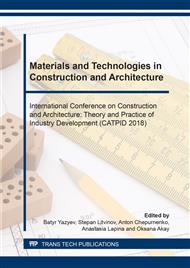p.60
p.66
p.72
p.78
p.84
p.91
p.100
p.107
p.113
The Impact of the Conical Indenter on a Plate Laying on a Winkler Foundation
Abstract:
In the practice of civil engineering, the methods of impact diagnostics of materials find their application, allowing quickly and accurately measure the required strength characteristics at any point in the structure. Impact methods offer many advantages, for example, at smaller dimensions can be developed big the contact force, it can be recorded more information about the response of the material to dynamic impact and others. This approach is widely used in determining the hardness of materials and makes it possible to determine the complex mechanical characteristics: yield strength, ultimate strength, and elongation. In the paper we consider the axisymmetric problem of the impact of the conical indenter on the plate, laying on Winkler Foundation under elastic-plastic deformation. The solution is based on the phenomenological model of elastic-plastic indentation in a quasistatic formulation. The general deformations of the plate are considered elastic, and the local, in the contact zone, are elastoplastic. The main characteristics of the impact are determined: the force of the contact interaction, the local indentation, the contact time. The device and methods of determining the strength characteristics of plates under specified conditions of impact were developed on the basis of obtained solutions. The proposed method has been tested on many building structures: bridges, trusses, structural structures of artificial structures, reinforcement bars, welded joints.
Info:
Periodical:
Pages:
84-90
Citation:
Online since:
September 2018
Keywords:
Price:
Сopyright:
© 2018 Trans Tech Publications Ltd. All Rights Reserved
Share:
Citation:


